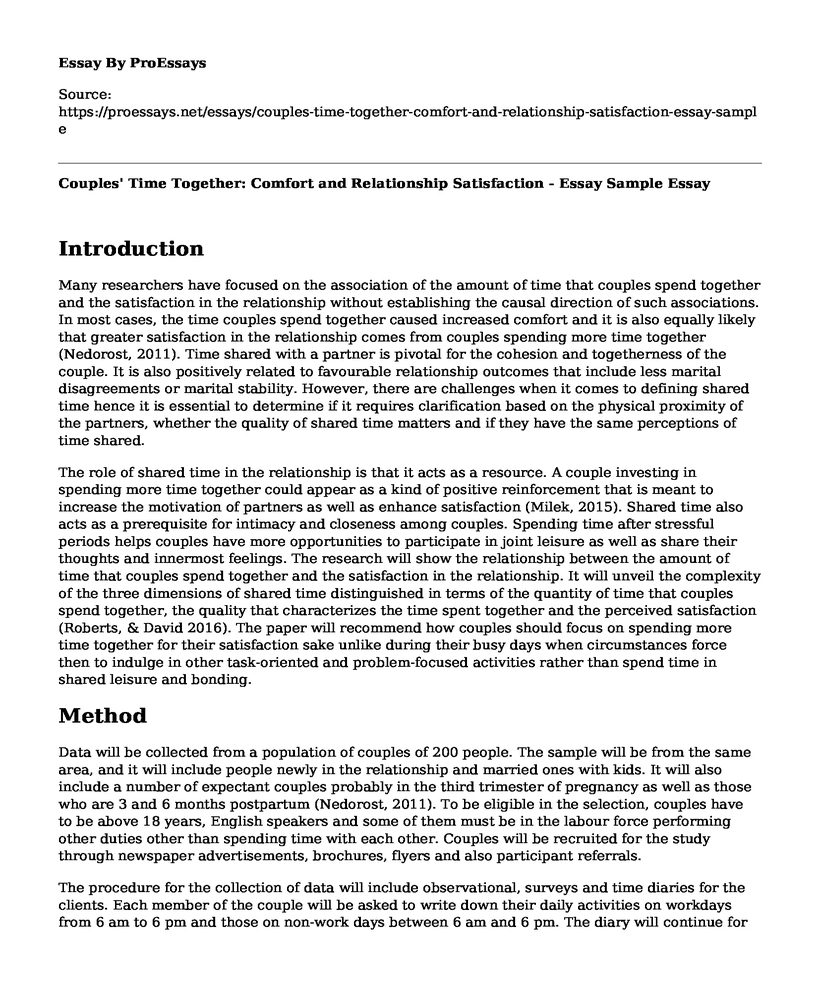Introduction
Many researchers have focused on the association of the amount of time that couples spend together and the satisfaction in the relationship without establishing the causal direction of such associations. In most cases, the time couples spend together caused increased comfort and it is also equally likely that greater satisfaction in the relationship comes from couples spending more time together (Nedorost, 2011). Time shared with a partner is pivotal for the cohesion and togetherness of the couple. It is also positively related to favourable relationship outcomes that include less marital disagreements or marital stability. However, there are challenges when it comes to defining shared time hence it is essential to determine if it requires clarification based on the physical proximity of the partners, whether the quality of shared time matters and if they have the same perceptions of time shared.
The role of shared time in the relationship is that it acts as a resource. A couple investing in spending more time together could appear as a kind of positive reinforcement that is meant to increase the motivation of partners as well as enhance satisfaction (Milek, 2015). Shared time also acts as a prerequisite for intimacy and closeness among couples. Spending time after stressful periods helps couples have more opportunities to participate in joint leisure as well as share their thoughts and innermost feelings. The research will show the relationship between the amount of time that couples spend together and the satisfaction in the relationship. It will unveil the complexity of the three dimensions of shared time distinguished in terms of the quantity of time that couples spend together, the quality that characterizes the time spent together and the perceived satisfaction (Roberts, & David 2016). The paper will recommend how couples should focus on spending more time together for their satisfaction sake unlike during their busy days when circumstances force then to indulge in other task-oriented and problem-focused activities rather than spend time in shared leisure and bonding.
Method
Data will be collected from a population of couples of 200 people. The sample will be from the same area, and it will include people newly in the relationship and married ones with kids. It will also include a number of expectant couples probably in the third trimester of pregnancy as well as those who are 3 and 6 months postpartum (Nedorost, 2011). To be eligible in the selection, couples have to be above 18 years, English speakers and some of them must be in the labour force performing other duties other than spending time with each other. Couples will be recruited for the study through newspaper advertisements, brochures, flyers and also participant referrals.
The procedure for the collection of data will include observational, surveys and time diaries for the clients. Each member of the couple will be asked to write down their daily activities on workdays from 6 am to 6 pm and those on non-work days between 6 am and 6 pm. The diary will continue for two weeks to get maximum details that can be analyzed to come up with a conclusion. If activities on the dairy seem too personal to share, the couples will be instructed to report only "personal time". The time diaries will be coded by the use of SPSS to analyze the relationship between the time spent and satisfaction for the couples derived from their activities.
References
Milek, A. (2015). Spending time with one's partner: the interplay between dimensions of shared time, external stress, and couples' relationship functioning (Doctoral dissertation, University of Zurich).
Nedorost, L. (2011). The Interplay of Couple Time Spent Together and Relationship Quality Across the Transition to Parenthood (Doctoral dissertation, The Ohio State University).
Roberts, J. A., & David, M. E. (2016). My life has become a significant distraction from my cell phone: Partner phubbing and relationship satisfaction among romantic partners. Computers in human behavior, 54, 134-141.
Cite this page
Couples' Time Together: Comfort and Relationship Satisfaction - Essay Sample. (2023, May 05). Retrieved from https://proessays.net/essays/couples-time-together-comfort-and-relationship-satisfaction-essay-sample
If you are the original author of this essay and no longer wish to have it published on the ProEssays website, please click below to request its removal:
- Brief Description of My Community - Course Work Example
- Methods of Communication in the Organization Essay Example
- Essay on Caring for Adolescents and Young Adults: Addressing Risks With Therapeutic Interventions
- Gender & Sexuality - Annotated Bibliography
- Essay on Empowering Youth to Tackle Modern Challenges: Education for the Future
- Persuasive Communication: Making a Bold Statement to Motivate Change - Essay Sample
- Paper Example on Patients' Communication: Improving Quality of Care at Torin Regional Hospital







